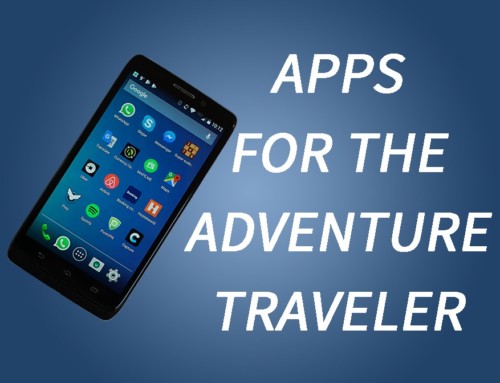There are many ways to call from overseas. You will easily find a lot of information outlining the various methods on how to do so. But what I am going to do is explain in detail what the one best way is for almost all international travelers, whether on a cruise around New Zealand and Australia or backpacking for a year.
What I consider to be the best way is one that most people are unfamiliar with and thus are most uncomfortable with trying. And who wants to leave on an international trip not feeling confident that they are going to be able to communicate the way they want? Most people aren’t willing to take a chance on the unfamiliar. That is how cell phone companies get away with selling international cell phone calling plans at outrageously expensive rates. Don’t do it!
My goal with this article is to give you all the details needed on how best to call from overseas so that you feel confident that you can do it. The method I am going to show you is both the most inexpensive method as well as the best method. So if you want to know how more just keep reading. And if by any chance I miss any detail you have a question about just add a remark and I’ll answer it for you.
Before Leaving Home
- Make sure your phone is “unlocked.” This simply means that you can remove your phone’s SIM card for your normal carrier, insert a SIM card from another carrier, and have the phone work. US carriers must provide unlocked phones. If your phone is locked get it unlocked. I had Verizon so I know that all the phones they sell are indeed unlocked.
- Make sure your phone will work on the GSM platform. This is the platform used in almost every country around the world. If your phone has a SIM card then it is GSM. If it does not then it is CDMA. Either obtain a phone with a SIM card or if you don’t want to do that you can stop reading this article here :-).
- Sign up for a Skype account if you don’t already have one. I subscribe to the “Unlimited US & Canada” plan and pay annually for some savings. This subscription costs about $30/year. If you are from another country I am sure Skype has similar plans for your home country. I will talk more about using Skype later in this article but I am mentioning it hear because you must sign up for this plan before leaving home. If you are reading this and you have already left home go to go this link about using VPN services and problem solved.
- When you get on the plane to fly to a foreign country (or before crossing the border from your home country or region that your home cell service is included) remove your existing SIM card and store it in a safe place. I store mine in a plastic case as shown here which I also use to store my MicroSD cards. This can be a stressful step for someone. Most people have never taken the SIM card out of their phone. Rest assured it is okay to do. Nothing bad will happen. If you do happen to lose your SIM card it is no big deal. When you get back to your home country you can get a replacement, usually free of charge from your carrier.

Know how to remove your phone’s SIM card.
Note: This step is important to avoid accidental charges by your cell service provider when you arrive in a foreign country. It can happen that even if you turn off your phone’s data setting and/or have it on airplane mode that those settings somehow get changed and all the sudden you start getting emails, text messages, and phone calls even before you get out of customs and get hit with expensive and unnecessary charges.

A simple plastic SD card holder comes in very handy.
You Are in a Foreign Country, Now What?!
First of all if you are North American you need to understand that it is extremely easy in almost every country in the world outside of the US and Canada to obtain a SIM card for the country you are in at very, very affordable prices. Almost all airports just outside of customs will have kiosks for cell phone service providers. I travel by motorcycle a lot so to not forget about my fellow overland travelers, while many borders are in remote places and there are no cell phone service kiosks at the border you only have to make it to the nearest town to find one.
The only thing you will need to do is to go a cell service provider kiosk and purchase a SIM card and service plan.

Typical airport arrival lobby with cellular provider stores.
One thing to consider each time you arrive in a new country is whether you need cellular access to the Internet, phone, and text.
Maybe you are only going to be in a country a few days. Maybe you just want a “vacation” from being constantly connected. Then consider whether you need cellular access or not. If you decide you don’t then skip the SIM card for this country. Remember, almost anywhere you will be going, free Wi-Fi will be widely available. North Americans will be surprised about just how widely available Wi-Fi is in other parts of the world. If on the other hand you are traveling to the US and Canada beware, Wi-Fi is not nearly as ubiquitous as one might think or even close to what it is in other countries around the world. The point is, if you are not going to be needing or wanting constant connectivity then you may not want to get a SIM.

Free Wi-Fi Zone signs found everywhere outside North America.
Before deciding against a SIM consider the added benefits of constant connectivity:
- When you are away from free Wi-Fi zones and need help you are out of luck without a SIM.
- Calling local numbers. It is much cheaper with a local SIM (usually free) than even using VOIP service you may have through Skype or other providers.
- Connecting to free Wi-Fi services such as at Starbucks (Turkey) and McDonalds (Austria) in some countries requires you to enter a code sent via text message. Without a local SIM this is not possible. Believe me, I know from personal experience how frustrating that can be!
- Having access to tourist information, news, and more any time
- Being able to receive calls from family in case of emergencies even when not connected to a Wi-Fi network.
What to Know About SIM Cards & Service Plans
First you need a SIM card. It will be free or cost only a couple of dollars.

SIM cards come in 2 sizes, both sizes found everywhere.
Then you need a service plan. They come in all “shapes and sizes” but the basics are the same. From my experience the 2 key components to a plan that I look for is the amount of data and the length of time the plan is valid. Very seldom did I need to make in-country phone calls. Most data plans included a certain number of call minutes and text messages within the country regardless of the amount of data you purchased. If you follow along with what I present in this article you will never be using the cellular calling capability to make international calls (such as calling family back home) so you don’t ever have to figure that into your calculation of the plan to choose. So don’t let that confuse you when shopping for the service plan.
So, How Much Data to Get?
I use my data plan for making VOIP calls via WhatsApp, Skype, and Messenger, all text messaging, browsing the web for information and news, using various apps that use Internet data, and on occasion uploading photos to Instagram, Twitter, and Facebook. I do try to keep the photo uploads to a minimum though and I turn off photo-syncing with my cloud storage application, Dropbox. Using data in this manner I find that I can get by with about 1 GB of data a week.
In the US and Canada data plans are extremely expensive and there are few options. But around the world it really is inexpensive. In Kyrgyzstan I spent about $3 per week for all the data I needed.
Getting Setup
You don’t have to worry about getting the SIM card to work. The setup of a new SIM card varies by country and carrier. So it is pointless trying to explain the actual methods here. All you need to know is whoever you purchase the SIM from will also be able to install and activate it. I found this to be true whether I got it from a fancy air-conditioned store or from a hole-in-the-wall Kiosk.
Why Are Local SIM Cards The Best Option
So I don’t want to cover all the various options that exist from International Calling Plans from your home carrier, to International SIM cards that work for multiple countries and are purchased before leaving home, and many other options. Instead I will focus on the benefits of going the route of using local SIM cards. Here they are:
- Very easy to obtain.
- Very inexpensive. Even if you are only in a country for a few days it is worth getting if staying connected to the Internet is important to you.
- You can choose your plan for each country as your needs in one country may be different than in another. This is a huge, huge advantage to other options.
- You get the best possible coverage since you can choose which carrier you want to use in a country and you are their customer.
- If you have any issues with your service it is easy to get support since your provider is local.
Got SIM, Got Service Plan, Now for Communicating
So, now down to the communicating part. With the SIM card activated and a service plan purchased you are now connected all the time as long as there is cellular service available and that is pretty ubiquitous even in the most underdeveloped countries.
You will now have access to all your web-based communications apps like Messenger, Facebook, WhatsApp, Skype, or whatever you use. There are a few notable exceptions in certain countries like Turkmenistan, Iran, and China but it is not related to your SIM card but because some apps are blocked in general.
Using Skype & Why I Like It
When in a foreign country I find that I still need to call the US and Canada often enough. Sure, with my family and friends I can use WhatsApp or Messenger but if I need to call banks, businesses, technical support, government agencies, and people that still primarily use a landline then without Skype I am out of luck when it comes to a cheap option for calling. Of course as alluded to above I could use the cellular service through my local SIM card but that would be the same as making an international phone call and would be very expensive.
With my Skype Unlimited Canada & US plan I can make those calls to land lines at no additional cost. It doesn’t matter what country I am physically when I make the call just so the number I am calling is in Canada or the US.
I also buy credit on Skype for when I need to make calls to countries not in Canada or the US. I often find myself in a foreign country; let’s say Papua New Guinea and I want to call Argentina. Well, by having pre-paid credit on Skype I can make that call at Skype’s extremely good rates (you can check them out here https://secure.skype.com/en/calling-rates?expo365=empty). This would be much cheaper than making an international call via the local cellular service provider. And I don’t know but it may not even be possible on an International calling plan you might get from your home country service provider.
If you are a true long-term adventure traveler like me you may even want to get a Skype virtual phone number. I do and at a cost of about $30/year. I actually got rid of my cell phone service in the US when I started traveling. I know many people wouldn’t even consider doing that but I did say “true long-term adventure traveler.” A Skype virtual number is a phone number that anyone can call as if you were in your home country; the USA in my case. This is very convenient to have if you have no US landline or cell service plan. Those who want to communicate with you but don’t use VOIP applications (Grandparents for example) or business that you still maintain a relationship with such as credit card companies, banks, and doctors can call the Skype virtual number. If you are connected to Wi-Fi at the time of the call your phone rings and you can answer no matter where you are in the world. If you are not connected to Wi-Fi at the time of a call the caller gets your voice mail and you will be notified of a missed call and waiting voice mail message. It works really great and while in my case it does not get used much it is still very important to have when on the road for months at a time.

My Skype account showing my pre-paid credit for calls to non-US/Canada numbers, unlimited US/Canada calling plan, and my virtual phone number subscription.
So Now You Are Convinced a Local SIM Card is the Way to Go…
I know that if you have never taken your SIM card out of your phone before that it can seem a bit scary to leave on an International journey thinking you will do what I’ve discussed here. But you will no doubt be surprised just how easy it really is.
Are you worried that the country or countries you are going to will not have SIM cards available? Let me put you at ease. I have been to 118 countries as of this writing. The only country I have been to that did not have SIM cards available was Tuvalu, a very tiny island country in the South Pacific. I survived 2 days there without. Just saying. Another little trick I use is just before going to my next foreign country I Google “Cellular Service Providers in” + name of country. I then can see which providers there are, how they rate in coverage, plans, and pricing. Then when I arrive in a new country I know exactly what I am looking for.
So, in Summary:
- Have an unlocked cell phone with a SIM card and learn how to access the SIM card. It is easier on some phones than others.
- Once signed up with Skype purchase a calling plan and optionally a virtual phone number
- Remove your home SIM card upon boarding your International flight or before crossing a border overland.
- Upon arrival in a foreign country, purchase a SIM card and service plan.
- Make sure it is setup and activated before leaving the store or kiosk.
- Start having fun knowing you are covered.
I hope this in-depth article gives you the confidence you need to stay connected and safe while traveling the world.
One more thing! Now that you know how to get and stay connected and call from overseas while traveling check out another great article of ours called “Essential Travel Apps.” This article is not about travel apps but about useful apps for the traveler. There is a difference as you’ll see.
Anecdote:
In spring, 2017 I took a cruise of New Zealand and Australia. In Auckland prior to boarding the ship I got a New Zealand SIM card. As the ship hugged the eastern coastline for the first 5 days of the cruise I noticed that I was getting a cellular signal even while the ship was at sea. I was able to book rental cars in my next port of call, research things to do in the ports, check the weather, and even check out news from home all from my cell phone at no cost other than my cheap data plan that cost only a few bucks. I would go by the Internet Café on board where people were using the ship’s Internet packages at rates of upwards to hundreds of dollars and I could only smile at my own good foresight…and sympathize with their waste of good money.
Thanks for reading! Any comments or questions?
We love hearing from our readers. Did this post get you thinking? Maybe you have a question about this subject or comments that other readers will be interested in. Please share in the Comments section below.




Amazing information you have shared. In my opinion, Google Duo works best. Though I have not travelled much, I know it will work awesomely. Thanks for sharing this post.
I have never tried Google Duo. I guess I like WhatsApp the best because it is so widely used. Everyone I meet traveling the world uses WhatsApp. I will have to try Google Duo though to see for myself the differences. Thanks for sharing.
Hi Guys,
Good stuff.
Big fan of calling through Google Voice or these days Whats App. Simple, easy and free, provided you’ve a solid internet connection. Easy peasy really once you link up as contacts.
Ryan